ava集合---LinkedList源码解析
一、源码解析
public class LinkedList<E> extends AbstractSequentialList<E> implements List<E>, Deque<E>, Cloneable, java.io.Serializable
LinkedList是一个继承于AbstractSequentialList的双向链表,它可以被当做堆栈、队列或双端队列进行操作
LinkedList实现了List接口,能够对它进行队列操作
LinkedList实现了Deque接口,即能将LinkedList当成双端队列使用
LinkedList实现了Cloneable接口,覆盖了clone()方法。可以进行克隆
LinkedList实现了Serializable接口,这意味着,LinkeList支持序列化操作。能通过序列化去传输
LinkedList是非同步的
为什么要继承自AbstractSequentialList ?
AbstractSequentialList 实现了get(int index)、set(int index, E element)、add(int index, E element) 和 remove(int index)这些骨干性函数。降低了List接口的复杂度。这些接口都是随机访问List的,LinkedList是双向链表;既然它继承于AbstractSequentialList,就相当于已经实现了“get(int index)这些接口”。
此外,我们若需要通过AbstractSequentialList自己实现一个列表,只需要扩展此类,并提供 listIterator() 和 size() 方法的实现即可。若要实现不可修改的列表,则需要实现列表迭代器的 hasNext、next、hasPrevious、previous 和 index 方法即可。
LinkedList的类图关系:
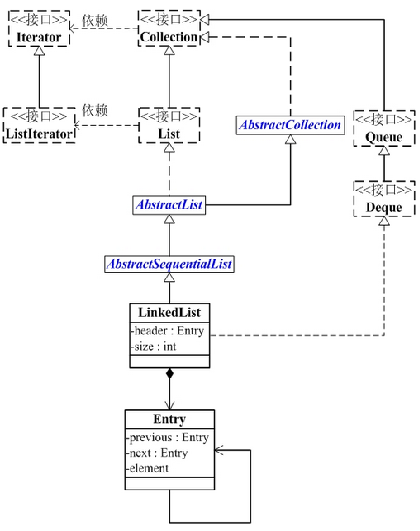
2.linkedList数据结构原理
LinkedList底层的数据结构是基于双向链表的,且头结点中不存放数据如下图
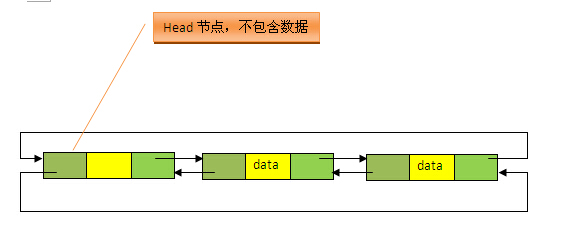
既然是双向链表,那么必定存在一种数据结构------我们被称为节点,节点实例保存业务数据,前一个节点的位置信息和后一个节点的位置信息如下图所示

3.私有属性
LinkedList中定义了两个私有属性
private transient Entry<E> header = new Entry<E>(null, null, null);
private transient int size = 0;
header是双向链表的头节点,它是双向链表节点所对应的类Entry的实例。Entry中包含成员变量: previous, next, element。其中,previous是该节点的上一个节 点,next是该节点的下一个节点,element是该节点所包含的值。
size是双向链表中节点实例的个数。
首先来了解节点类Entry类的代码。
private static class Entry<E> { E element; Entry<E> next; Entry<E> previous; Entry(E element, Entry<E> next, Entry<E> previous) { this.element = element; this.next = next; this.previous = previous; } }
节点类很简单,element存放业务数据,previous与next分别存放前后节点的信息(在数据结构中我们通常称之为前后节点的指针)。
4.LinkedList的构造方法:
public LinkedList() { header.next = header.previous = header; } public LinkedList(Collection<? extends E> c) { this(); addAll(c); }
第一个构造方法不接受参数,将header实例的previous和next全部指向header实例(注意,这个是一个双向循环链表,如果不是循环链表,空链表的情况应该是header节点的前一节点和后一节点均为null),这样整个链表其实就只有header一个节点,用于表示一个空的链表。
执行完构造函数后,header实例自身形成一个闭环,如下图所示:
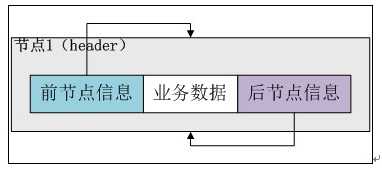
第二个构造方法接收一个Collection参数c,调用第一个构造方法构造一个空的链表,之后通过addAll将c中的元素全部添加到链表中。
5.元素的添加
public boolean addAll(Collection<? extends E> c) { return addAll(size, c); } // index参数指定collection中插入的第一个元素的位置 public boolean addAll(int index, Collection<? extends E> c) { // 插入位置超过了链表的长度或小于0,报IndexOutOfBoundsException异常 if (index < 0 || index > size) throw new IndexOutOfBoundsException("Index: "+index+ ", Size: "+size); Object[] a = c.toArray(); int numNew = a.length; // 若需要插入的节点个数为0则返回false,表示没有插入元素 if (numNew==0) return false; modCount++;//否则,插入对象,链表修改次数加1 // 保存index处的节点。插入位置如果是size,则在头结点前面插入,否则在获取index处的节点插入 Entry<E> successor = (index==size ? header : entry(index)); // 获取前一个节点,插入时需要修改这个节点的next引用 Entry<E> predecessor = successor.previous; // 按顺序将a数组中的第一个元素插入到index处,将之后的元素插在这个元素后面 for (int i=0; i<numNew; i++) { // 结合Entry的构造方法,这条语句是插入操作,相当于C语言中链表中插入节点并修改指针 Entry<E> e = new Entry<E>((E)a[i], successor, predecessor); // 插入节点后将前一节点的next指向当前节点,相当于修改前一节点的next指针 predecessor.next = e; // 相当于C语言中成功插入元素后将指针向后移动一个位置以实现循环的功能 predecessor = e; } // 插入元素前index处的元素链接到插入的Collection的最后一个节点 successor.previous = predecessor; // 修改size size += numNew; return true; }
构造方法中的调用了addAll(Collection<? extends E> c)方法,而在addAll(Collection<? extends E> c)方法中仅仅是将size当做index参数调用了addAll(int index,Collection<? extends E> c)方法。
private Entry<E> entry(int index) { if (index < 0 || index >= size) throw new IndexOutOfBoundsException("Index: "+index+ ", Size: "+size); Entry<E> e = header; // 根据这个判断决定从哪个方向遍历这个链表 if (index < (size >> 1)) { for (int i = 0; i <= index; i++) e = e.next; } else { // 可以通过header节点向前遍历,说明这个一个循环双向链表,header的previous指向链表的最后一个节点,这也验证了构造方法中对于header节点的前后节点均指向自己的解释 for (int i = size; i > index; i--) e = e.previous; } return e; }
下面说明双向链表添加元素的原理:
6.添加元素add
// 将元素(E)添加到LinkedList中 public boolean add(E e) { // 将节点(节点数据是e)添加到表头(header)之前。 // 即,将节点添加到双向链表的末端。 addBefore(e, header); return true; } public void add(int index, E element) { addBefore(element, (index==size ? header : entry(index))); } private Entry<E> addBefore(E e, Entry<E> entry) { Entry<E> newEntry = new Entry<E>(e, entry, entry.previous); newEntry.previous.next = newEntry; newEntry.next.previous = newEntry; size++; modCount++; return newEntry; }
addBefore(E e,Entry<E> entry)方法是个私有方法,所以无法在外部程序中调用(当然,这是一般情况,你可以通过反射上面的还是能调用到的)。
addBefore(E e,Entry<E> entry)先通过Entry的构造方法创建e的节点newEntry(包含了将其下一个节点设置为entry,上一个节点设置为entry.previous的操作,相当于修改newEntry的“指针”),之后修改插入位置后newEntry的前一节点的next引用和后一节点的previous引用,使链表节点间的引用关系保持正确。之后修改和size大小和记录modCount,然后返回新插入的节点
下面分解“添加第一个数据”的步骤:
第一步:初始化后LinkedList实例的情况:
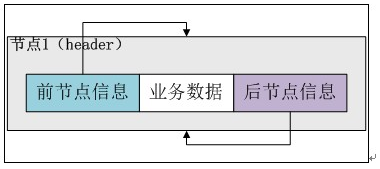
第二步:初始化一个预添加的Entry实例(newEntry)。
Entry newEntry = newEntry(e, entry, entry.previous);
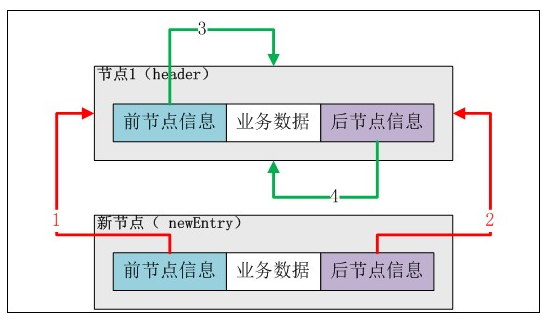
第三步:调整新加入节点和头结点(header)的前后指针。
newEntry.previous.next = newEntry;
newEntry.previous即header,newEntry.previous.next即header的next指向newEntry实例。在上图中应该是“4号线”指向newEntry。
newEntry.next.previous = newEntry;
newEntry.next即header,newEntry.next.previous即header的previous指向newEntry实例。在上图中应该是“3号线”指向newEntry。
调整后如下图所示:
图——加入第一个节点后LinkedList示意图

下面分解“添加第二个数据”的步骤:
第一步:新建节点。
图——添加第二个节点
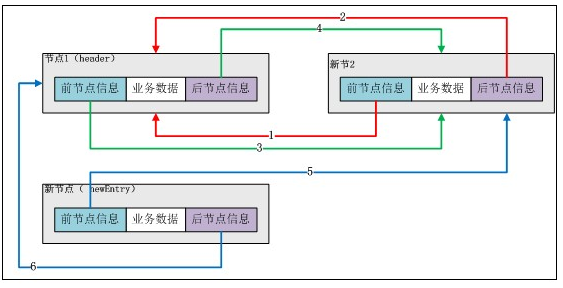
添加后续数据情况和上述一致,LinkedList实例是没有容量限制的
总结,addBefore(E e,Entry<E> entry)实现在entry之前插入由e构造的新节点。而add(E e)实现在header节点之前插入由e构造的新节点。为了便于理解,下面给出插入节点的示意图。
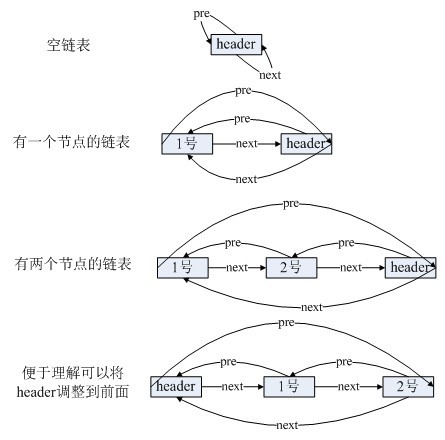
public void addFirst(E e) { addBefore(e, header.next); } public void addLast(E e) { addBefore(e, header); }
看上面的示意图,结合addBefore(E e,Entry<E> entry)方法,很容易理解addFrist(E e)只需实现在header元素的下一个元素之前插入,即示意图中的一号之前。addLast(E e)只需在实现在header节点前(因为是循环链表,所以header的前一个节点就是链表的最后一个节点)插入节点(插入后在2号节点之后)。
7.清除clear()方法
public void clear() { Entry<E> e = header.next; // e可以理解为一个移动的“指针”,因为是循环链表,所以回到header的时候说明已经没有节点了 while (e != header) { // 保留e的下一个节点的引用 Entry<E> next = e.next; // 解除节点e对前后节点的引用 e.next = e.previous = null; // 将节点e的内容置空 e.element = null; // 将e移动到下一个节点 e = next; } // 将header构造成一个循环链表,同构造方法构造一个空的LinkedList header.next = header.previous = header; // 修改size size = 0; modCount++; }
8.数据包含contains(Object)
public boolean contains(Object o) { return indexOf(o) != -1; } // 从前向后查找,返回“值为对象(o)的节点对应的索引” 不存在就返回-1 public int indexOf(Object o) { int index = 0; if (o==null) { for (Entry e = header.next; e != header; e = e.next) { if (e.element==null) return index; index++; } } else { for (Entry e = header.next; e != header; e = e.next) { if (o.equals(e.element)) return index; index++; } } return -1; }
indexOf(Object o)判断o链表中是否存在节点的element和o相等,若相等则返回该节点在链表中的索引位置,若不存在则放回-1
contains(Object o)方法通过判断indexOf(Object o)方法返回的值是否是-1来判断链表中是否包含对象o。
9.删除数据remove()
几个remove方法最终都是调用了一个私有方法:remove(Entry<E> e),只是其他简单逻辑上的区别。下面分析remove(Entry<E> e)方法
private E remove(Entry<E> e) { if (e == header) throw new NoSuchElementException(); // 保留将被移除的节点e的内容 E result = e.element; // 将前一节点的next引用赋值为e的下一节点 e.previous.next = e.next; // 将e的下一节点的previous赋值为e的上一节点 e.next.previous = e.previous; // 上面两条语句的执行已经导致了无法在链表中访问到e节点,而下面解除了e节点对前后节点的引用 e.next = e.previous = null; // 将被移除的节点的内容设为null e.element = null; // 修改size大小 size--; modCount++; // 返回移除节点e的内容 return result; }
由于删除了某一节点因此调整相应节点的前后指针信息,如下:
e.previous.next = e.next;//预删除节点的前一节点的后指针指向预删除节点的后一个节点。
e.next.previous = e.previous;//预删除节点的后一节点的前指针指向预删除节点的前一个节点。
10.清空预删除节点:
e.next = e.previous = null;
e.element = null;
交给gc完成资源回收,删除操作结束。
与ArrayList比较而言,LinkedList的删除动作不需要“移动”很多数据,从而效率更高。
11.数据获取get
Get(int)方法的实现在remove(int)中已经涉及过了。首先判断位置信息是否合法(大于等于0,小于当前LinkedList实例的Size),然后遍历到具体位置,获得节点的业务数据(element)并返回。
注意:为了提高效率,需要根据获取的位置判断是从头还是从尾开始遍历。
// 获取双向链表中指定位置的节点 private Entry<E> entry(int index) { if (index < 0 || index >= size) throw new IndexOutOfBoundsException("Index: "+index+ ", Size: "+size); Entry<E> e = header; // 获取index处的节点。 // 若index < 双向链表长度的1/2,则从前先后查找; // 否则,从后向前查找。 if (index < (size >> 1)) { for (int i = 0; i <= index; i++) e = e.next; } else { for (int i = size; i > index; i--) e = e.previous; } return e;
注意细节:位运算与直接做除法的区别。先将index与长度size的一半比较,如果index<size/2,就只从位置0往后遍历到位置index处,而如果index>size/2,就只从位置size往前遍历到位置index处。这样可以减少一部分不必要的遍历
12.数据复制clone(0和toArray()
public Object clone() { LinkedList<E> clone = null; try { clone = (LinkedList<E>) super.clone(); } catch (CloneNotSupportedException e) { throw new InternalError(); } clone.header = new Entry<E>(null, null, null); clone.header.next = clone.header.previous = clone.header; clone.size = 0; clone.modCount = 0; for (Entry<E> e = header.next; e != header; e = e.next) clone.add(e.element); return clone; }
调用父类的clone()方法初始化对象链表clone,将clone构造成一个空的双向循环链表,之后将header的下一个节点开始将逐个节点添加到clone中。最后返回克隆的clone对象
toArray()
public Object[] toArray() { Object[] result = new Object[size]; int i = 0; for (Entry<E> e = header.next; e != header; e = e.next) result[i++] = e.element; return result; }
创建大小和LinkedList相等的数组result,遍历链表,将每个节点的元素element复制到数组中,返回数组。
toArray(T[] a)
public <T> T[] toArray(T[] a) { if (a.length < size) a = (T[])java.lang.reflect.Array.newInstance( a.getClass().getComponentType(), size); int i = 0; Object[] result = a; for (Entry<E> e = header.next; e != header; e = e.next) result[i++] = e.element; if (a.length > size) a[size] = null; return a; }
先判断出入的数组a的大小是否足够,若大小不够则拓展。这里用到了发射的方法,重新实例化了一个大小为size的数组。之后将数组a赋值给数组result,遍历链表向result中添加的元素。最后判断数组a的长度是否大于size,若大于则将size位置的内容设置为null。返回a
从代码中可以看出,数组a的length小于等于size时,a中所有元素被覆盖,被拓展来的空间存储的内容都是null;若数组a的length的length大于size,则0至size-1位置的内容被覆盖,size位置的元素被设置为null,size之后的元素不变。
为什么不直接对数组a进行操作,要将a赋值给result数组之后对result数组进行操作?
13.遍历数据 Iterator
LinkedList的Iterator
除了Entry,LinkedList还有一个内部类:ListItr。
ListItr实现了ListIterator接口,可知它是一个迭代器,通过它可以遍历修改LinkedList。
在LinkedList中提供了获取ListItr对象的方法:listIterator(int index)。
public ListIterator<E> listIterator(int index) { 2 return new ListItr(index); 3 }
该方法只是简单的返回了一个ListItr对象。
LinkedList中还有通过集成获得的listIterator()方法,该方法只是调用了listIterator(int index)并且传入0。
二、ListItr
下面详细分析ListItr。
private class ListItr implements ListIterator<E> { // 最近一次返回的节点,也是当前持有的节点 private Entry<E> lastReturned = header; // 对下一个元素的引用 private Entry<E> next; // 下一个节点的index private int nextIndex; private int expectedModCount = modCount; // 构造方法,接收一个index参数,返回一个ListItr对象 ListItr(int index) { // 如果index小于0或大于size,抛出IndexOutOfBoundsException异常 if (index < 0 || index > size) throw new IndexOutOfBoundsException("Index: "+index+ ", Size: "+size); // 判断遍历方向 if (index < (size >> 1)) { // next赋值为第一个节点 next = header.next; // 获取指定位置的节点 for (nextIndex=0; nextIndex<index; nextIndex++) next = next.next; } else { // else中的处理和if块中的处理一致,只是遍历方向不同 next = header; for (nextIndex=size; nextIndex>index; nextIndex--) next = next.previous; } } // 根据nextIndex是否等于size判断时候还有下一个节点(也可以理解为是否遍历完了LinkedList) public boolean hasNext() { return nextIndex != size; } // 获取下一个元素 public E next() { checkForComodification(); // 如果nextIndex==size,则已经遍历完链表,即没有下一个节点了(实际上是有的,因为是循环链表,任何一个节点都会有上一个和下一个节点,这里的没有下一个节点只是说所有节点都已经遍历完了) if (nextIndex == size) throw new NoSuchElementException(); // 设置最近一次返回的节点为next节点 lastReturned = next; // 将next“向后移动一位” next = next.next; // index计数加1 nextIndex++; // 返回lastReturned的元素 return lastReturned.element; } public boolean hasPrevious() { return nextIndex != 0; } // 返回上一个节点,和next()方法相似 public E previous() { if (nextIndex == 0) throw new NoSuchElementException(); lastReturned = next = next.previous; nextIndex--; checkForComodification(); return lastReturned.element; } public int nextIndex() { return nextIndex; } public int previousIndex() { return nextIndex-1; } // 移除当前Iterator持有的节点 public void remove() { checkForComodification(); Entry<E> lastNext = lastReturned.next; try { LinkedList.this.remove(lastReturned); } catch (NoSuchElementException e) { throw new IllegalStateException(); } if (next==lastReturned) next = lastNext; else nextIndex--; lastReturned = header; expectedModCount++; } // 修改当前节点的内容 public void set(E e) { if (lastReturned == header) throw new IllegalStateException(); checkForComodification(); lastReturned.element = e; } // 在当前持有节点后面插入新节点 public void add(E e) { checkForComodification(); // 将最近一次返回节点修改为header lastReturned = header; addBefore(e, next); nextIndex++; expectedModCount++; } // 判断expectedModCount和modCount是否一致,以确保通过ListItr的修改操作正确的反映在LinkedList中 final void checkForComodification() { if (modCount != expectedModCount) throw new ConcurrentModificationException(); } }
下面是一个ListItr的使用实例。
LinkedList<String> list = new LinkedList<String>(); list.add("First"); list.add("Second"); list.add("Thrid"); System.out.println(list); ListIterator<String> itr = list.listIterator(); while (itr.hasNext()) { System.out.println(itr.next()); } try { System.out.println(itr.next());// throw Exception } catch (Exception e) { // TODO: handle exception } itr = list.listIterator(); System.out.println(list); System.out.println(itr.next()); itr.add("new node1"); System.out.println(list); itr.add("new node2"); System.out.println(list); System.out.println(itr.next()); itr.set("modify node"); System.out.println(list); itr.remove(); System.out.println(list);
结果: [First, Second, Thrid] First Second Thrid [First, Second, Thrid] First [First, new node1, Second, Thrid] [First, new node1, new node2, Second, Thrid] Second [First, new node1, new node2, modify node, Thrid] [First, new node1, new node2, Thrid]
LinkedList还有一个提供Iterator的方法:descendingIterator()。该方法返回一个DescendingIterator对象。DescendingIterator是LinkedList的一个内部类。
public Iterator<E> descendingIterator() { 2 return new DescendingIterator(); 3 }
下面分析详细分析DescendingIterator类。
private class DescendingIterator implements Iterator { // 获取ListItr对象 final ListItr itr = new ListItr(size()); // hasNext其实是调用了itr的hasPrevious方法 public boolean hasNext() { return itr.hasPrevious(); } // next()其实是调用了itr的previous方法 public E next() { return itr.previous(); } public void remove() { itr.remove(); } }
从类名和上面的代码可以看出这是一个反向的Iterator,代码很简单,都是调用的ListItr类中的方法



